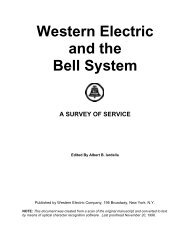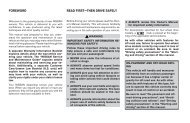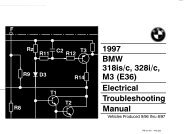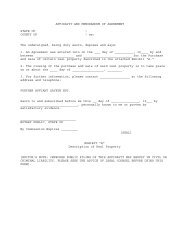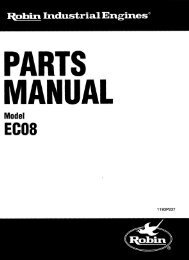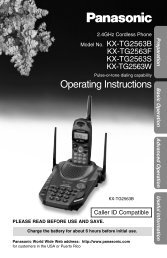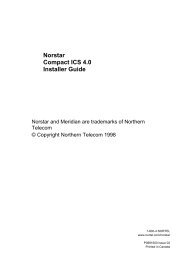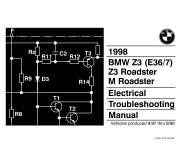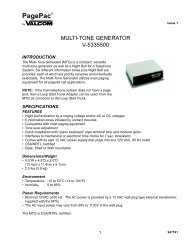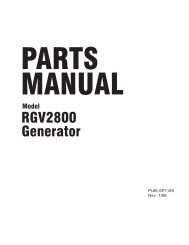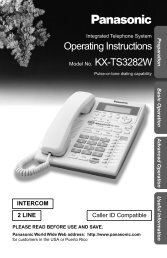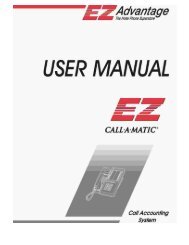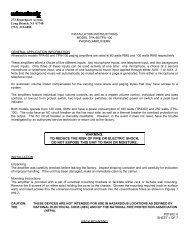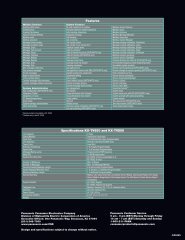Western Electric Catalogue #1 - Wedophones.com wedophones
Western Electric Catalogue #1 - Wedophones.com wedophones
Western Electric Catalogue #1 - Wedophones.com wedophones
You also want an ePaper? Increase the reach of your titles
YUMPU automatically turns print PDFs into web optimized ePapers that Google loves.
92 WESTERN ELECTRIC COMPANY<br />
Signalling Systems-Continued<br />
that positive and negative pulsating current may be sent out over either side of the line to ground by means<br />
of a party line ringing key for each cord circuit or a master key for all of the cord circuits in the position .<br />
Center Checking . This system is used on toll lines where it is desired to have several stations on one line,<br />
and yet require all of them to secure connections entirely through one office . The<br />
ringers at the stations are all biased and bridged across the line in one way, that is, they either operate on<br />
alternating current or on pulsating current in one direction only . The generators at the stations are all<br />
arranged to furnish pulsating current of the polarity which does not ring the bells ; and accordingly it is<br />
impossible for one party on the line to call another, except through the center checking operator . The<br />
central office has a bridged drop, operated by the pulsating current, and rings the different parties on the line<br />
by means of a code system .<br />
Central Office Selective Signalling. This is just the reverse of the center checking system, that is, there<br />
may be placed a large number of subscribers on one line, and they can<br />
call one another without signalling central office ; or they can call central office without notifying the other<br />
parties on the line . This is ac<strong>com</strong>plished in two ways .<br />
The first method is to bridge across the lire bells which are biased so that they operate on alternating<br />
or pulsating current in one direction . The hand generators in the telephone sets normally deliver tc the<br />
two sides of the lines alternating current ; but when a button is depressed there is delivered to the two sides<br />
of the line pulsating current of a polarity which will not operate the bells . This current, however, will throw<br />
the drop at the central office . This drop is arranged so that it will not operate on alternating current<br />
which, as explained before, is ordinarily used to signal the other subscribers on the line . The central office<br />
rings the desired party by a code system .<br />
The other method is to use unbiased ringers and alternating current generators at the telephone<br />
stations . The generators normally deliver current to the two sides of the line but when a push button at<br />
any set is depressed the generator is connected between one side of the line and ground . At the central<br />
office a drop of the regular type is wired from one side of the line to ground and accordingly is not operated<br />
unless a subscriber rings with the push button in his set depressed .<br />
CENTRAL BATTERY SYSTEMS<br />
Code Ringing. Several parties may be connected to one line in the central battery system, the bells all<br />
being bridged across the line and biased . The line at the central office is wired the same<br />
as for single party line service . One party cannot call another on the same line, except through the central<br />
office operator, and central office calls the desired party by a code system of ringing .<br />
2 Party Selective Ringing . With this system two parties may be connected to one line, the two bells being<br />
biased and connected to ground, one from each side of the line . The line at<br />
the central office is wired the same as for single party line service, and the cord circuits are arranged<br />
so that alternating current may be sent out over either side of the line by means of a key for each cord<br />
circuit, or a master key for all of the cord circuits in the position .<br />
4 Party Selective Ringing . Four parties may be connected to one line, and the line arranged so that any<br />
party may be called without signalling the others . There is bridged across the<br />
line at each station a high impedance relay, from the local contacts of which the four ringers are wired to<br />
ground .<br />
These relays are arranged so that when they operate they connect to ground the four ringers,<br />
two from each side of the line . These ringers are biased and wired -so that one of the pair on each side of<br />
the line operates on positive pulsating and the other operates on negative pulsating current . One party<br />
cannot call another on the same line, except through the central office operator .<br />
The line circuit at the central office is wired the same as for single party line service . The cord circuits<br />
are arranged so that the operator may ring over one side of the line to ground with either positive or negative<br />
pulsating current . With either of these currents all four relays on the line operate, connecting to ground<br />
all four bells . As the operator rings on only one side of the line with pulsating current of one polarity, only<br />
the bell on that side of the line which is connected to respond to that polarity will sound . During conversation<br />
all ground connections are open at the substations .<br />
4 Party Semi-Selective Ringing . This is the same as the two party selective system, except that there are<br />
connected to ground two stations from each side of the line . The oper<br />
ator thus can ring either pair of bells without operating the other pair . The operator uses a code system<br />
of ringing to distinguish between the two parties which form a pair connected to each side of the line .<br />
PRICES ON REQUEST



